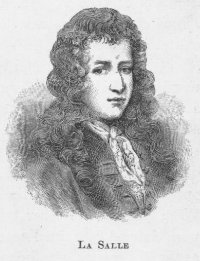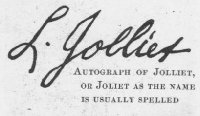THE FRENCH IN LOUISIANA
Nicollet’s early expeditions. Saint Lusson claims the West for France. Marquette and Joliet explore the upper Mississippi. La Salle descends to the mouth. The French claim to Louisiana. Tonty and other pioneers. The founders of New Orleans. The search for a way to the western ocean. Le Sueur and other explorers. The Verendryes see the Rocky Mountains.
It was nearly a century after the disastrous end of De Soto’s journey and the return of Coronado’s expedition before the first representative of the New France, which was pressing up the St. Lawrence, reached a tributary of the Mississippi. This was Jean Nicollet, a French interpreter of Three Rivers, whose journey westward as far as Green Bay and the Wisconsin River about 16341 was due to tales of a strange people, who, it was held, might be the Chinese. This Oriental myth, which persisted so long, was not shattered by Nicollet’s discovery that these "Orientals" were really Winnebago Indians. He returned believing that the Wisconsin River, which he claimed2 to have reached and descended for a distance, had borne him within three days’ journey of the sea.
Tales of the great river, the "Mesipi" of the Sioux, were brought back by adventurous French traders and priests in the years that followed Nicollet’s quest. "Through what regions did it flow?" In Parkman’s eloquent words, "Whither would it lead them, — to the South Sea or the Sea of Virginia, to Mexico, Japan or China? The problem was soon to be solved and the mystery revealed."
Of the gallant French explorers who first penetrated the interior of our country, one of the bravest and deservedly most famous was Robert Cavelier, born at Rouen in 1643 and best known as La Salle. At the age of twenty-three he came to Canada. He became seignior of an estate near Montreal, but ambition, love of adventure, an ardor for discovery and conquest  soon led him to the exploration of the unknown West. It seems certain that in 1669 he journeyed from Lake Erie to a branch of the Ohio and descended at least as far as the falls at Louisville. But a more glorious journey of discovery was yet to come.
soon led him to the exploration of the unknown West. It seems certain that in 1669 he journeyed from Lake Erie to a branch of the Ohio and descended at least as far as the falls at Louisville. But a more glorious journey of discovery was yet to come.
At nearly the same time Jean Talon, intendant of Canada, was making the first formal move in the great game which was to checkmate England and Spain by a French control of the interior that would confine England to the eastern seaboard and hold the Spaniards at bay in the south and southwest. It was with this in view that in 1670 he ordered Daumont de Saint Lusson to Lake Superior to take possession of the interior. It was early in May that the French soldiers and priests assembled on a hill near the foot of the Sault Sainte Marie, surrounded by wondering Indians, who watched them raise a cross and place beside it a post bearing the arms of France. All the known country of the Great Lakes, all the contiguous countries discovered and undiscovered, "bounded on the one side by the seas of the North and of the West, and on the other by the South Sea," were claimed by Saint Lusson, sword in hand, as the possessions of "the most High, Mighty and Redoubted Monarch, Louis, Fourteenth of that name, Most Christian King of France and of Navarre."
Such was the proud claim of France covering the valley of the Mississippi and the country to the west; but of the geography of much of the western territory the French had little more knowledge than the Spaniards in 1493 when the bull of Pope Alexander VI divided the Western World between the Spaniards and Portuguese. 
Of the many French soldiers, priests, traders
and adventurers associated with the early history of the Louisiana Territory, the most famous are Father Marquette and the La Salle whom we have met at the outset of his
career. It was in 1673, sixty-five years after Samuel de Champlain founded Quebec, that Louis Joliet, an agent of Count Frontenac, governor of New France, or Canada, and Father Marquette, a Jesuit priest of singular devoutness and unflinching courage, were commissioned to discover the great river which had proved so elusive, — the Mississippi. From Mackinaw they journeyed to Green Bay and entered Fox River. With the aid of Indian guides they found their way to a portage which brought them to the Wisconsin River. "They bade farewell to the waters that flowed to the  St. Lawrence, and committed themselves to the current that was to bear them, they knew not whither,—perhaps to the Gulf of Mexico, perhaps to the South Sea, or the Gulf of California." 3
St. Lawrence, and committed themselves to the current that was to bear them, they knew not whither,—perhaps to the Gulf of Mexico, perhaps to the South Sea, or the Gulf of California." 3
On June 17 they reached the present site of Prairie du Chien. Wisconsin, and there before them stretched the stream which was the object of their quest. Day after day, in spite of strange and terrifying adventures, they kept their way down the great river, passing the mouth of the Missouri, which Lewis and Clark were afterwards to ascend, and finally reaching the mouth of the Arkansas. They were seven hundred miles from the mouth of the Mississippi, although they thought themselves much nearer; but their journey had made it clear that the Mississippi flowed southward to the Gulf of Mexico. This fact was ascertained, and, since below them lay danger from hostile Indians and possibly from Spaniards, they reëmbarked on July 17, and set forth on their arduous return journey to report their discovery. In accordance with the custom of these pioneer priests Father Marquette kept a careful journal, and this "Relation," as it is called, preserves the record of the perilous quest of a classic figure in the discovery of the West.4

FATHER MARQUETTE
(From Trentanove's statue in the Capitol at Washington)
This is an ideal figure. In 1897 a painting was discovered in Montreal which is claimed to be a portrait.
1 As to the question of date see Winsor, Vol. IV, p. 304.
Return to text.
2 C. W. Butterfield’s "History of Discovery by Jean Nicollet," etc. (Cincinnati, 1881), indicates that Nicollet did not descend the Wisconsin. he was, however, the first white man to reach Green Bay.
Return to text.
3 Parkrnan, "La Salle and the Discovery of the Great West."
Return to text.
4 Mr. Reuben G. Thwaite’s "Father Marquette" is an excellent presentation of this story.
Return to text.
Continue
Back to Legacy
© 2001, Lynn Waterman